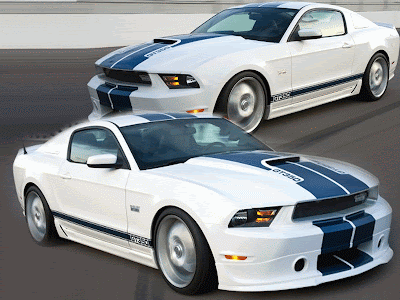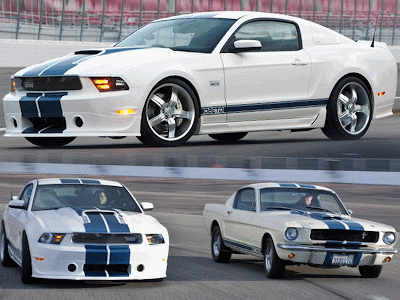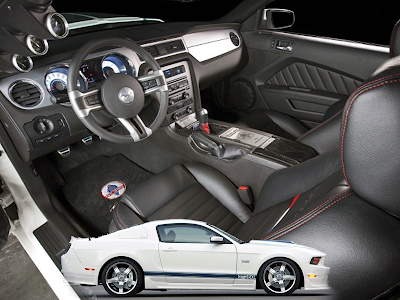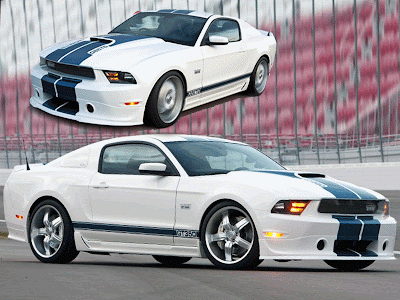
Automotive legend Carroll Shelby shares his 85th birthday with a new performance standout – the 540-horsepower 2008 GT500KR, which begins production today.
The GT500KR or “King of the Road” Mustang is the fourth limited-edition Mustang that Shelby Automobiles and Ford have brought to market since resuming their collaboration in 2001. It builds on the performance and success of the 500-horsepower Shelby GT500 – the most powerful production Mustang ever.
The new GT500KR will be available at select Ford dealerships this spring. Production is limited at 1,000 units.
It is simply magic when Shelby and Ford team up and deliver products like the GT500KR,” said Mark Fields, Ford’s president, The Americas. “Collaborations like this have helped Mustang remain at the top of the sports car segment for 22 straight years – and running – and help inspire people who truly want and value performance.”
Carroll Shelby, who was actively involved in the GT500KR’s development, said: “My energy and passion for performance products has always been strongest when I am working with Ford. I’m always looking to up the ante when it comes to performance, and bringing back the ‘King of the Road’ Mustang is just what we need.”
Delivering the “King of the Road”
Each Shelby GT500KR begins life as a GT500, built at AutoAlliance International Inc., in Flat Rock, Mich. From there, the cars are shipped to Shelby Automobile’s facility in Las Vegas, where a Ford Racing performance pack, exhaust system and short-throw shifter are installed. The GT500KR also is fitted with body, chassis and interior components. Every GT500KR will be hand customized and delivered to each customer in an enclosed transporter, just like the legendary Ford GT.
To fine-tune the GT500KR’s chassis – stiffened 50 percent to deliver increased body control – SVT engineers and Shelby put the GT500KR through a rigorous testing program developed specially for SVT products, including a 12-hour racetrack durability test. The result is a car with increased performance capability that is still comfortable to drive on the street.
The GT500KR’s aerodynamics were fine-tuned to add 50 pounds of downforce over the front axle and move the center of aero pressure forward in the vehicle to improve high-speed balance and downforce under high-speed braking. A new front splitter design works with the hood and revised rear spoiler to deliver these benefits. The bottom line: the GT500KR sets new performance standards for Mustang handling and straight-line performance on the racetrack, slalom course and skidpad.
“Because the Shelby GT500 strikes a great balance between ride and handling, we knew that the GT500KR had to be even better,” said Jamal Hameedi, chief engineer at Ford SVT. “We used a holistic approach, having chassis engineers work closely with the engine specialists to develop a tuning suspension that optimizes the engine enhancements.”
Added Gary Davis, vice president production for Shelby Automobiles: “We aren’t fixing our attention on one or two attributes, but working on the vehicle as a whole. The throttle response, power delivery, exhaust note and handling all work together to deliver a great total driving experience.”
To deliver that balance, the ride height has been lowered to the optimum setting for limit handling, which equates to a 20 mm ride height reduction in the front and 15 mm in the rear.
The Shelby GT500KR team sculpted a modern interpretation of the original’s bulging hood scoop, a visual indication of the extra horsepower packed beneath it. The hood is secured by a pair of stainless steel, twist-down hood pins.
To save weight, the hood borrows design elements from the ducted aluminum/carbon fiber clamshell on the Ford GT. Developed through intensive use of analytical tools including Computational Fluid Dynamics (CFD) and Finite Element Analysis (FEA), the design optimizes the structural properties of carbon fiber delivering panels at a wafer-thin 0.8 mm. The hood saves 15 pounds versus its aluminum counterpart in the GT500.
Unlike most traditional designs, the hood has three components: the outer panel, an integrated airflow duct which spans the entire hood and the inner panel. The duct serves three purposes: to channel supplemental fresh air into the new cold air intake, to relieve high-speed underhood pressure and to move air from the front intake and engine compartment to the rear extractors.
The Shelby GT500KR will ride on all-new Goodyear tires, which make their North American debut exclusively on this new Mustang. The Supercar F1 tire, made of a new performance compound, resulted from a special collaboration between SVT and Goodyear.
Each GT500KR model is identified by a special 40th Anniversary badge on the fenders and grille, distinctive body colored mirror caps and Shelby lettering stretching across the front of the hood and along the rear portion of the deck lid. a special Shelby VIN tag is affixed to each vehicle, mounted in the engine compartment.
The all-leather interior features Carroll Shelby signature embroidered headrests and an official Shelby CSM 40th Anniversary GT500KR dash plate mounted at the top of the center stack.
Other standard equipment includes HID headlamps, an interior ambient lighting package, wrapped and stitched instrument panel, center console and armrests, as well as an electrochromic rearview mirror. Optional equipment includes a Shaker 1000 audio system and DVD navigation system.
The GT500KR’s 5.4-liter V-8 Gets the Royal TreatmentJust like its namesake, the 1968 GT500KR, the 2008 “King of the Road” packs a walloping dose of Ford performance. The Ford SVT-engineered 5.4-liter supercharged V-8 is enhanced with a Ford Racing Power Upgrade Pack that boosts horsepower to an estimated 540-hp and torque to 510 ft.-lbs. The added power comes thanks to revised ignition and throttle calibration and a cold air intake system that replaces the stock unit. The Shelby GT500KR cold air intake seal was designed in unison with the new carbon fiber hood to prevent hot engine compartment air from reaching the air intake.
Calibration modifications include advancing the ignition timing as well as re-mapping the electronic throttle settings to provide quicker throttle response for better off-line and mid-range acceleration. Increased throttle response will be met with a sharper roar from the Ford Racing-inspired exhaust system.
Power is delivered to the rear wheels through a Tremec TR6060 six-speed manual transmission and 3.73:1 rear axle ratio, compared with the GT500’s 3.31:1.
To perform optimally on track and during performance driving, the Shelby GT500KR has been fitted with an elevated axle vent reservoir to prevent axle fluid expulsion. Gear selection is courtesy of an all-new Ford Racing short-throw shifter making its debut on the GT500KR. Topped with a white ball, the new shifter throws are 25 percent shorter than the unit on the GT500 providing for crisper, sharper shifts.














































